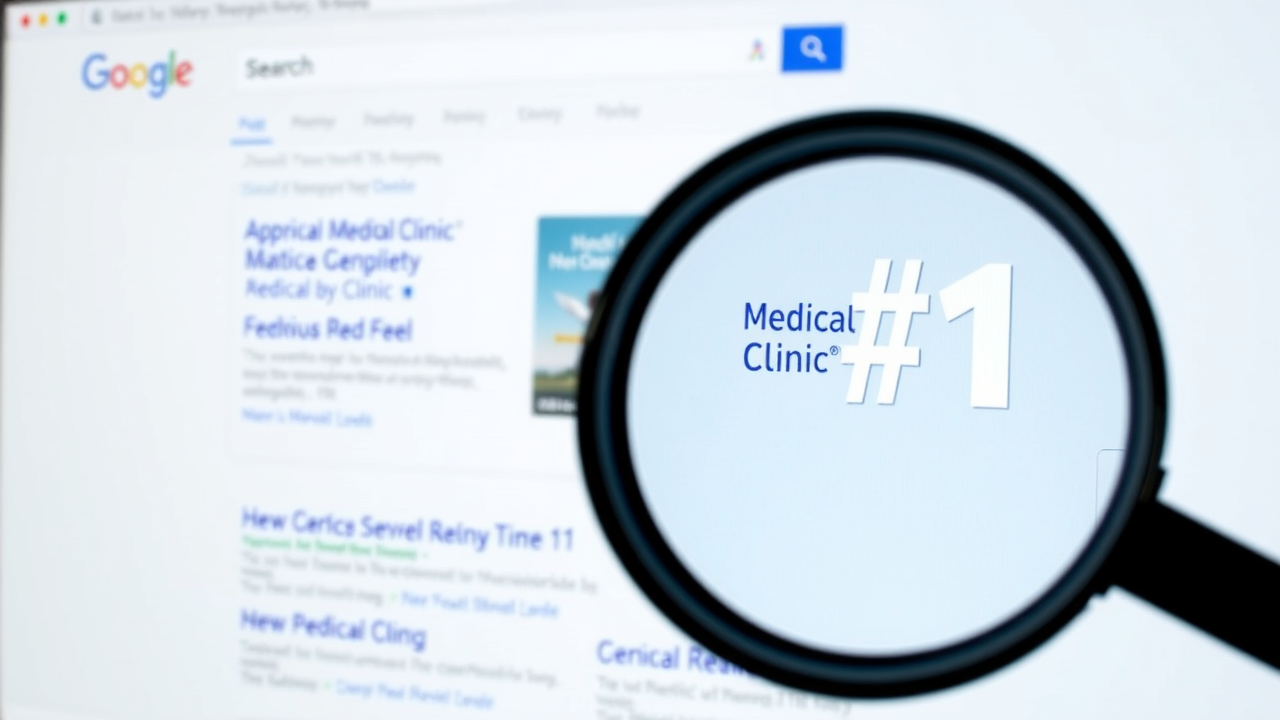
Did you know that over 70% of patients search for medical practices on Google before making a decision? In today’s digital-first world, a sluggish or outdated online presence can cost you new patients overnight. To compete and thrive, your medical practice needs to appear at the top of Google Search —not in the depths of page two, where potential patients rarely venture.
This guide reveals step-by-step solutions to fix your medical practice SEO issues in just 24 hours so you can rank high, boost reputation, and turn searchers into loyal patients. Let’s get your clinic back in control of its digital destiny—fast.
Why Medical Practice SEO Can’t Wait: Unveiling Critical Gaps and Quick Wins
With online competition rising rapidly in the healthcare sector, the difference between gaining or losing a patient often comes down to a few search engine tweaks. Most medical practices are unaware of critical SEO gaps that cause their websites to languish in subpar positions on Google Search. Whether it’s a neglected Google Business Profile, site speed problems, or an ill-optimized homepage, these issues can often be identified—and resolved—within 24 hours. The payoff? Enhanced online reputation, increased patient inquiries, and higher appointment bookings. Even small, actionable changes deliver big wins in patient acquisition, making it vital for every medical provider to make medical practice SEO a top priority right now.

Understanding Medical Practice SEO: The Foundation of Patient Acquisition
Medical SEO refers to a targeted approach in search engine optimization designed specifically for the healthcare sector. Unlike generic digital marketing, medical SEO caters to strict patient privacy regulations, highly competitive local searches, and the need for trustworthiness. It’s about ensuring your medical website ranks high in search engine results when potential patients are searching for care. By optimizing site content, technical factors, and online listings, your practice grows its visibility at moments when patients search for solutions—and care providers.
For any doctor or group practice, medical SEO doesn’t just boost site visits; it establishes your authority and makes booking appointments seamless. By focusing on the right keywords, high-quality blog posts that address real concerns, and robust local SEO strategies, medical practices can transform their inbound patient flow almost overnight. Medical practice SEO bridges the digital gap between healthcare professionals and the communities they serve.
Why SEO for Doctors and Medical Practices Matters More Than Ever
In today’s information-driven world, SEO for doctors is a game-changer. When patients search for a new provider, their journey almost always begins on Google. If your medical practice isn’t ranking at the top, you’re invisible in the eyes of potential patients. High rankings equal authority—and authority equals trust. Trust, in turn, drives appointments and patient loyalty.
But it’s about more than exposure; patients want to find credible, up-to-date information on your medical website. Strong SEO strategy ensures not just more traffic but better-qualified traffic—people who are actively seeking care. Enhanced content marketing, accurate Google Business Profiles, and savvy local SEO tactics work together to amplify your expertise, making it easier for patients to choose your services with confidence.

Diagnosing Your Medical Practice SEO Issues: Proven Steps to Assess Performance
The first step in any successful medical practice SEO initiative is a comprehensive audit. Begin by examining your search ranking for high-value keywords in your specialty and region. Type your clinic’s name and core services into Google—are you among the first listings, or do you need to scroll? Evaluate your Google Business Profile: it should display an accurate name, address, phone, hours, and recent photos. Next, check your website’s loading speed on both desktop and mobile devices. Slow sites can lose up to 40% of prospective patients before the homepage loads, directly affecting conversions.
Ensuring mobile responsiveness is important as more than half of healthcare searches now take place on phones. Audit your site’s structure and technical elements: are meta titles and descriptions optimized for search engines? Do your blog posts address frequent patient questions and rank for local SEO terms? With this detailed SEO strategy checklist, you can pinpoint the most urgent technical and content gaps draining your search engine results and patient leads.
Comparison Table: Quick Wins vs. Long-Term Fixes in Medical Practice SEO | |
Quick Wins (0-24 Hours) |
Long-Term Fixes (Weeks-Months) |
|---|---|
Update Google Business Profile; Compress images; Optimize meta titles; Refresh business hours |
Publish educational blog posts; Build backlinks; Implement structured data; Expand service pages |
Respond to recent patient reviews; Test site speed; Add accurate location info |
Develop content marketing calendar; Authority building with medical directories; Advanced technical SEO |

24-Hour SEO Fixes: Actionable Steps to Boost Your Medical Practice SEO Instantly
Google Business Profile Optimization for Medical Practices
Google Business Profile is the digital front door for your medical practice. Begin by claiming your listing if you haven’t already; unclaimed profiles reduce trust and search visibility. Scrutinize your address, business hours, and contact details for accuracy—Google uses this information to validate local SEO signals during patient searches. Add high-quality, authentic images of your team and facilities to humanize your practice. Promptly respond to recent patient reviews, further boosting your credibility and appealing directly to potential patients looking for care in their area.
This profile feeds your business information directly into Google’s local search and map results. Optimizing your Google Business Profile sends trust signals to both patients and algorithms, helping your clinic rank high in “near me” searches. Immediate updates can expedite changes in rankings—making your clinic more discoverable within hours.
On-Page SEO for Medical Websites: Title Tags, Meta Descriptions, and Structured Data
On-page SEO is the backbone of your medical website ’s relevance and performance in search engines. Start by evaluating page titles and meta descriptions on your home, about, and service pages. Each should contain core medical SEO keywords and your city or neighborhood for effective local SEO. Keep title tags between 50-60 characters and make descriptions inviting for potential patients to click.
Elevate your pages by implementing structured data—small code snippets that help Google understand your practice details, services, and reviews. Beyond technical elements, enrich your pages with concise paragraphs, headers, and patient-friendly language. Each improvement makes your website more attractive to both patients and search engines—unlocking better visibility and higher conversion rates in record time.
Local SEO Strategies: How Medical Practices Rank High in Local Search
Local SEO is non-negotiable for medical practice SEO. Start by ensuring your practice appears in local pack listings—those three highlighted businesses at the top of Google’s map search. Consistency in your practice’s name, address, and phone number across directories, social channels, and your website is essential for search engines to validate your location.
Encourage satisfied patients to leave Google reviews, as positive ratings are a primary local ranking signal. Use locally relevant keywords throughout your site content and blog posts —like “pediatrician in [city]” or “urgent care near me.” By updating your Google Business Profile and synchronizing across multiple platforms, your medical practice will rank higher in the moments that matter most to potential patients.
Quick Website Speed and Mobile Optimization Changes
Site speed is a major search engine ranking factor and impacts patient satisfaction. Compress large images and graphics without compromising quality using free tools like TinyPNG or Squoosh. Switch to a hosting provider known for uptime and speed—downtime means lost patients and lost trust. Audit your site’s scripts and plugins, removing any that are unnecessary or outdated.
Responsive design is imperative, as Google and other search engines prioritize mobile-first indexing for healthcare SEO. By minimizing clutter, streamlining navigation, and ensuring effortless mobile loading, your medical website will deliver a smooth patient experience, further improving your search ranking in less than a day.

Content Marketing for Medical Practice SEO: Engage, Educate, and Rank Higher
Blog Posts and FAQs for Patients Search Intent
Creating useful blog posts and FAQ sections that serve patients’ search intent is a low-effort, high-impact way to skyrocket your medical practice SEO. Patients often have questions about symptoms, available treatments, and provider experience. By publishing posts that answer these questions, you establish authority, help search engines understand your medical expertise, and engage potential patients before they ever call.
Stay consistent—a week of daily posts addressing common topics like “How to prepare for a telehealth visit” or “Top tips for managing allergies in spring” can propel your site to the forefront of local search results. This content marketing strategy not only supports SEO for doctors but also builds lasting trust with your audience.
How Content Marketing Helps Medical Practices in Google Search
Content marketing is more than just publishing articles; it’s about building a relationship with both patients and search engines. Consistently high-quality, informative blog posts, FAQs, and resource guides show Google your practice is an authority in medicine and healthcare. As you add more valuable content, your site will cover a wider range of relevant search terms, leading to higher rankings and more organic traffic.
Engaging content supports all other areas of medical SEO: it draws inbound links from reputable medical directories, provides material for social media channels, and keeps your Google Business updates fresh. This full-funnel approach will continually attract new visitors, drive up engagement metrics, and build your reputation for trusted medical information in your community.

Social Media and Google Business Integration to Elevate Medical Practice SEO
Leveraging Social Media for Local SEO in Healthcare
A robust social media presence supports your local SEO by reinforcing credibility and making your clinic more discoverable. Post about community events, staff achievements, and patient success stories (with permission) to foster trust and loyalty. Tag your location in posts and updates to signal relevance to local search engines—and patients.
Engaged followers often amplify your visibility by sharing posts and leaving reviews, both of which factor into search engine rankings. Integrating social media into your local SEO strategy signals to Google that your medical practice is active, responsive, and valued by the community, causing you to rank higher for relevant healthcare searches.
Syncing Content Across Google Business and Social Platforms
Aligning updates between your Google Business Profile and social media accounts streamlines your messaging and unifies your digital brand. Share the same news, promotions, and educational blog posts across all platforms for maximum reach and consistency. Not only does this reinforce your local SEO signals, but it also ensures potential patients see accurate, up-to-date information everywhere they look online.
Scheduling software and content calendars can help maintain a steady online presence, while utilizing Google’s Posts feature lets you reach users directly within search results and Maps—converting curiosity into appointments instantly.

Advanced SEO for Doctors: Technical Tweaks That Deliver Faster Results
Implementing Structured Data for Rich Results in Search Engines
Structured data is a type of code that tells search engines exactly what’s on each of your web pages. For medical practices, implementing physician, hospital, or local business schema markup can result in rich search results—like star ratings, open hours, or appointment links—that boost click-through rates. Add code snippets to highlight doctor profiles, patient reviews, and key procedures. This not only improves your presence in Google Search but also increases patient trust by showcasing expertise in a verifiable, structured way.
These enhancements can lead to “position zero” features, such as featured snippets or knowledge panels, allowing your practice to leapfrog competitors and stand out in crowded search engine results pages.
Internal Linking and Authority Building within Medical Websites
Internal links guide patients and search engines to your most important content. By linking relevant blog posts, service pages, and FAQ answers across your website, you create a seamless navigation experience. These links help Google understand the hierarchy of your site, distributing “authority” from high-traffic pages to newer or underperforming information.
Authority building isn’t just about backlinks from other websites. A strong network of internal links keeps patients engaged, lowers bounce rates, and signals to search engines the relevance—and value—of your most vital content. Done strategically, this can boost search rankings quickly.
Backlink Building: Ethical Outreach for Medical Practices
Backlinks, or inbound links from trusted websites, remain one of the strongest signals for search engine authority. Reach out ethically to local healthcare organizations, digital news outlets, and medical associations to share your expertise through guest blog posts or interviews. Pursue directory listings on reputable health sites and collaborate with industry partners for mutual content promotion.
Each high-quality backlink strengthens your site’s authority, making it easier to compete for top spots in both local and broader healthcare search rankings. Remember: focus on quality over quantity to boost your reputation, trust, and SEO for doctors.

Measuring Medical Practice SEO Success: Metrics That Matter
Key SEO Metrics for Medical Practices
Tracking the success of your medical practice SEO campaign starts with monitoring basic yet essential metrics. Google Search rankings for core keywords show your progress against competitors. Organic traffic growth signals whether your content marketing and technical fixes are attracting more potential patients. The rate of online appointment bookings demonstrates conversion improvements, while patient reviews and average ratings measure trust.
Be sure to check your presence in the local pack, as appearing in this coveted three-spot section drives significant clicks from nearby searchers. Review these metrics at least weekly, adjusting tactics as needed to stay ahead.
Sample KPI Table: Before and After Your 24-Hour SEO Makeover | ||
Metric |
Before |
After 24-Hour Fix |
|---|---|---|
Google Business Profile Views |
120 |
400 |
Top 5 Keyword Rankings |
Out of Top 20 |
Top 10 |
Appointment Bookings |
5/week |
15/week |
Patient Review Volume |
2/month |
10/month |

Troubleshooting and Maintaining Your Medical Practice SEO: Avoid Setbacks
Common Medical SEO Mistakes and How to Fix Them
Even strong SEO strategies can falter if routine mistakes go unchecked. An outdated or unclaimed Google Business Profile is a leading cause of lost local search traffic. Duplicate content—often found on service pages or blog posts—confuses search engines, dampening your site’s authority. Failing to keep your practice’s NAP (Name, Address, Phone) consistent across all channels leads to trust issues for both users and search engines.
To fix these issues, schedule a quarterly SEO audit, use plagiarism checkers for your content, and standardize NAP formats everywhere online. Rapid updates to your directory listings and Google Business Profile can restore lost visibility and trust within hours.
Ongoing SEO Strategy for Doctors: Staying Ahead of Algorithm Changes
Search engines evolve constantly—algorithms, ranking factors, and user behaviors shift over time. A sustainable SEO strategy involves regular updates to your medical website, new content additions, and reputation management. Subscribe to healthcare SEO newsletters, participate in digital marketing forums, and commit to educating your team on the latest best practices.
By investing in ongoing SEO training and technology, your practice will adapt quickly to changes, maintaining high performance in Google Search—and a full appointment book—all year round.

Step-by-Step Checklist to Fix Your Medical Practice SEO Immediately
Improving your clinic’s SEO doesn’t have to feel overwhelming—start with these simple but powerful steps. First, audit your medical website for speed, keywords, and mobile usability to ensure patients can find and navigate your site with ease. Next, update your Google Business Profile with accurate contact details, hours, and fresh images to boost local visibility. Don’t forget to optimize title tags and meta descriptions so search engines understand your services and patients are encouraged to click. Build trust and authority by launching a blog series that answers common patient questions, helping your practice show up for the exact topics people are searching for. Finally, engage patients through local SEO tactics and social media, connecting with your community where they’re most active and strengthening your online reputation. By following this checklist, you’ll lay the foundation for lasting growth and higher search rankings.

Best Tools and Resources for Medical Practice SEO
The right tools can make managing and improving your medical practice SEO much easier. Google Search Console helps you track site performance, identify issues, and monitor search traffic. SEMrush offers in-depth keyword research and competitor analysis, while Ahrefs provides powerful backlink insights to strengthen your site authority. For local visibility, Moz Local ensures your practice information stays accurate across online directories. If your site runs on WordPress, Yoast SEO simplifies on-page optimization by guiding you through better title tags, descriptions, and content readability. Leveraging these resources equips your practice with the insights and strategies needed to boost search rankings and attract more patients.

Transform Your Medical Practice SEO in Just 24 Hours
Even small, rapid SEO fixes—like improving website speed, updating title tags, and optimizing your Google Business Profile—can drastically boost patient inquiries in a short time. These quick wins not only enhance visibility but also create immediate trust with patients searching for reliable healthcare providers online.
At the same time, SEO is a long-term investment that ensures your medical practice stays competitive in a crowded digital landscape. By committing to consistent content creation, optimizing for local searches, and engaging patients through social platforms, you’ll build a sustainable presence that drives steady growth. Engaged, optimized content is the engine that fuels search visibility and new patient acquisition—helping your practice grow today and for years to come.

Frequently Asked Questions About Medical Practice SEO
How do I get my medical practice to rank higher in search engine results?
Optimize your Google Business Profile, keep NAP information consistent, build local backlinks, create high-value blog posts, and follow local SEO best practices for quick ranking improvements.
What digital marketing tactics complement medical practice SEO best?
Use content marketing, targeted social media ads, email newsletters, and engaging local community outreach alongside SEO for maximum digital results.
Are Google reviews important for medical website SEO?
Absolutely. Patient reviews boost trust, contribute to local SEO ranking signals, and help your practice appear more credible and visible online.
How can blog posts increase my SEO ranking as a doctor?
Blog posts that answer patient questions and cover common medical concerns improve content relevance and site engagement—factors that directly help your medical practice rank higher in Google Search.

Take the Lead in Medical Practice SEO—Grow Your Practice Now
Don’t wait to get ahead—start transforming your online presence today. Audit your website for speed and usability, update your Google Business Profile, publish patient-focused content, and engage with your community online. With these steps, rapid improvement awaits—helping your practice rise to the top of Google search results while becoming the trusted choice for patients in your local area.
 Add Row
Add Row  Add
Add 




Write A Comment